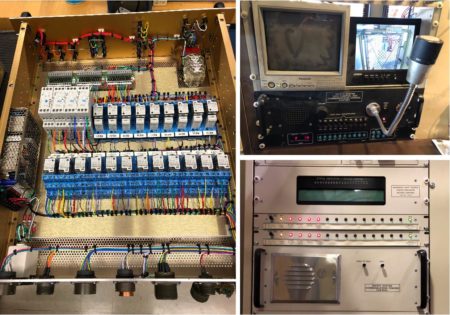
The Users’ Executive Committee presented Bob Gassaway with the Tim Renner User Services Award at the 2018 User Meeting, recognizing his longstanding commitment to simultaneously supporting the ALS user community and advancing electrical safety at the ALS. Gassaway is an electronics engineering technologist who came to Berkeley Lab in 1988 after ten years at Lawrence Livermore National Laboratory, where he had learned to build projects according to military specifications. Together with Electrical and Controls Engineering Leader Ken Baptiste, he built the ALS’s linear accelerator in Building 46, which they installed when Building 6 was ready. In the ensuing 30 years, Gassaway has left his mark. From the linear accelerator, to the booster and storage rings, and out to the beamlines, it is difficult to find a space without a Gassaway-built chassis or device.
A typical project begins when a coordinator approaches Gassaway with a schematic. Gassaway gives his feedback and accounts not just for where a power supply, safety device, or other electrical equipment will be installed, but also plans for accessibility for future maintenance. He has also developed the walk-in work request system, which has been valuable when a user travels from afar for beam time but has forgotten a crucial cable that Gassaway helps replace.
The ALS mission to support users in doing outstanding science in a safe environment often requires some modifications to users’ original plans and equipment to conform to ALS safety requirements. Bruce Rude, senior scientific engineering associate, nominated Gassaway for the Renner Award because he is “meticulous and thorough, has a good grasp of safety, and works to the very highest standards in this trade.”
ALS Research Scientist David Kilcoyne noted how Gassaway embodies two essential components of the mission: user support and safety. “The rigorous and precise attention to detail that Bob brings to his work results in ‘works of art’ and has been recognized by his peers for many years. One simply has to look inside one of the boxes Bob assembles to wonder how he manages to interpret the complex 2D electronic and electrical drawings into a 3D physical and complicated functioning entity with logical electronic and electrical circuits and components that are at the heart of an accelerator’s operations.”

When Chemical Safety Specialist Doug Taube sought to implement a safety device to monitor levels of dangerous gases, he turned to Gassaway. “When Bob does something, it’s timely, it’s safe, and it’s art,” said Taube. “The original design was a box on a box on a box,” Gassaway explained. “I consolidated it into one box, locked the parts that shouldn’t be touched, and opened a window for the measurements to be displayed. When you’ve worked somewhere for 30 years, you don’t want to run out of challenges. I like to make the products look good.”

Gassaway’s precise and painstaking work has saved many an experiment. Rude described how Gassaway’s problem solving during the swing shift has assisted many users when complications threatened the loss of valuable beam time. “I have personally witnessed many instances of experimenters walking in ‘after hours’ with electrical aberrations or connector failures that need to be repaired or brought up to ALS standards, and Bob has dropped what he was doing to help.”
Kevin Wilson, interim director of the Chemical Sciences Division, which operates Beamline 9.0.2, has firsthand experience with Gassaway’s contributions to the ALS user community. “He helped us arrive at a particularly important solution that requires taking a continuous reading of a high-voltage resistor chain. He designed and fabricated an isolated multimeter in a box that has provided reliable readings in a safe way. His work is superb and has been in operation on one of our instruments for the past eight years.”
The ALS team is committed to providing a safe facility for users to conduct groundbreaking research, and Gassaway has been instrumental in building this environment. When he retires in June 2019, he will be leaving behind a monumental legacy. “Because I’ve been here since day one, I’ve helped come up with solutions to problems we’d never seen before. I try to mentor the younger staff, to impart what I’ve learned.” His work exemplifies the qualities celebrated by the Tim Renner User Service Award.
Tim Renner was a beamline scientist at the ALS whose battle with cancer cut short a career distinguished by a caring attitude and larger-than-life personality. This award recognizes the services of people across the ALS organization who have made outstanding contributions to the ALS user community.